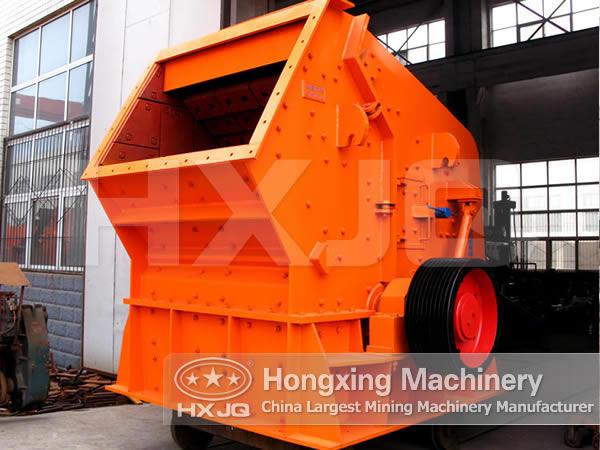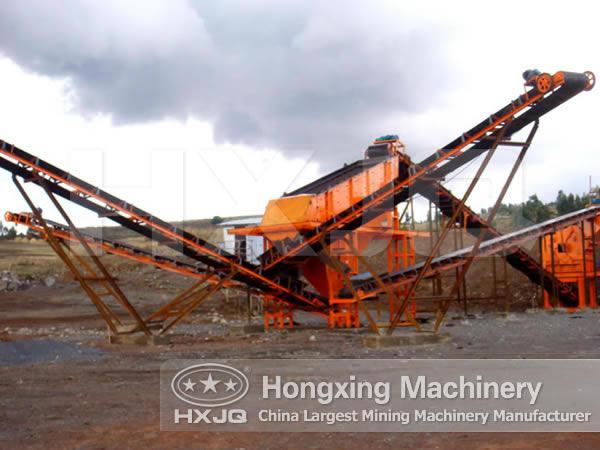A complete set of cement production line include several types of machines such as belt conveyor, handcart, preblending bed, raw material burdening station, raw material mill, raw material homogenization silo, preheater, decomposing furnace, rotary kiln, clinker cooling machine, clinker silo, cement proportioning bin, cement mill, dust catcher, bucket elevator and packing machine. The technical process of a cement making plant generally includes crushing and homogenization, raw material preparation, raw material homogenization, preheating and decomposition, clinker calcinations, cement grinding and packing. Here these seven links of cement production line will be introduced here in detail.
1. Crushing and homogenization
(1) Crushing: in the production process of cement, the majority of raw materials need to be crushed such as limestone, clay, iron ore and coal. Limestone is a type of raw materials with the largest use when producing cement, and the just-mined limestone is usually large and high in hardness, for this reason, the crushing of limestone has a crucial role in the material crushing process of cement plant.
The commonly used crushing equipment has jaw crusher,impact crusher,hammer crusher and so on.


.jpg)
(2) Material homogenization: homogenization technology refers to the function of applying scientific material piling and fetching technology to realize the primary homogenization of materials and make the storage yard of raw materials have the function of both storage and homogenization in the storage and fetching process of materials.
2. Raw material preparation
In the cement production process, at least three ton of materials need to be ground including all kinds of raw materials, fuel, clinker, mixture and gypsum for producing every ton of Portland cement. According to statistics, the power needed for the dry type cement production line accounts over 60% of the total power of the whole cement plant, among which, raw material grinding accounts for over 30%, coal grinding for 3% and cement grinding for 40%. For this reason, reasonably choosing powder grinding mills and technical process, optimizing the technical parameters, correctly operating the machine and controlling the working system have great significance to ensure product quality and reduce energy consumption.
The commonly used Raw material preparation equipment is raw material mill.
.jpg)
3. Raw material homogenization
In the production process of new type of dry type cement, stabilizing the component of raw materials that go into the kiln is the premise of stabilizing the calcination thermal regulation of clinker and raw material homogenization plays the role of stabilizing the component of raw materials.
4. Preheating and decomposition
Complete the preheating of part decomposition of raw materials with preheater to replace part function of rotary kiln to shorten the length of rotary kiln. At the same time, it can make the air in the accumulation state inside the kiln to move to preheater to complete the heat exchange in the suspension state, so that raw materials can fully mix with the hot air discharged from the kiln, thus increasing the contact area of air of materials and improving the heat transfer speed and heat transfer efficiency and reaching the goal of improving the production system of the kiln system and reducing the heat consumption of clinker calcinations.
5. Calcination of cement clinker
After raw materials are preheated and predecomposed inside cyclone preheater, they will go into rotary kiln for clinker calcinations. Inside rotary kiln, carbonate will quickly further decompose and have a series of solid-phase reaction to produce mineral admixtures of cement clinker. With the increase of the temperature of materials, the mineral mixtures will become liquid and decompose to react and produce plenty of clinker. After the clinker is calcined, its temperature will decrease. Finally cement clinker cooling machine will be used for cooling the high-temperature clinker discharged from rotary kiln to the temperature that can be endured by downstream conveying, storage bin and cement mill, and at the same time, it can recycle the waste air of high-temperature clinker, thus improving the heat efficiency of the system and the clinker quality.
The commonly used equipment is cement rotary kiln.
.jpg)
6. Cement grinding
Cement grinding is the last procedure of cement production as well as a procedure with the highest electricity consumption. Its main function lies in grinding the cement clinker to suitable granularity, form a certain particle grading, increase its hydration area, increase the hydration speed and stasfy the condensation and hardening requirement of cement mortar.
The commonly used equipment is cement mill.

7. Cement packing
When leaving the factory, cement has two delivery methods: in bags and in bulk.
In addition, the commonly used equipment as well as belt conveyor,bucket elevator.

.jpg)